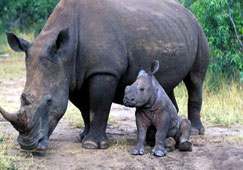Regulated horn trade 'could save rhinos'
4 July 2013
Establishing a well-regulated international trade in rhino horn could help to curb rhino poaching, if implemented along with other interventions, says South African Environmental Affairs Minister Edna Molewa.
"We will have to work in partnership with stakeholders and experts to ensure a
feasible model for trade is proposed at the next COP in South Africa, with due
consideration of all the views expressed by interested and affected stakeholders
in rhino conservation," Molewa told a briefing in Pretoria on Wednesday.
Cabinet has approved the development and submission of a proposal to the 17th
Conference of Parties of the Convention on the International Trade of Endangered
Species of Wild Fauna and Flora (CITES), scheduled to take place in 2016 in South
Africa, to introduce regulated international trade in rhino horn.
Long-term conservation strategy
Molewa said discussions on a possible legal trade, as part
of South Africa's long-term
conservation strategy for rhinos, were initiated at the 16th COP to CITES.
She also said South Africa had the means to make rhino horn available without
impacting on the species, and the implementation of a regulated trade system would
help to achieve that.
Deputy director-general of biodiversity and conservation at the Environmental Affairs
Department, Fundisile Mketeni, said government rhino horn stockpiles stood at 16 437 kilograms, while private sector stockpiles were 2 091kgs.
While the proposal for the sale of rhino horn is yet to be finalised, Mketeni said the
money made from rhino horn would be used for conservation, research and
community participation.
"We need to go and clear the stock we have. We would like to sell the horns as a
whole. It will depend on the trading partner because they know better [where] there
is demand. What we seek to address now is the black market, which [has] demand
because
there is usage out there," Mketeni said.
'Working closely with neighbours'
Meanwhile, Molewa said South Africa was still working closely with neighbouring
Mozambique on the issue of re-erecting the park fence in a bid to stop poachers
from entering the country.
When the Great Limpopo Transfrontier Park was officially declared in 2002, 20 metres
of the fence separating the Kruger National Park (KNP) from the Limpopo National
Park (LNP) in Mozambique was cut down.
Many rhino poachers are believed to enter South Africa from Mozambique in the area
where the border fence between KNP and LNP was removed to allow the
development of the multi-national park.
KNP has borne the brunt of rhino poaching, and Mozambique is also experiencing a
problem with elephant poaching.
Molewa said Mozambique has reported that they have funding available to begin
moving communities who are still residing in the park.
"Our plan was to
re-erect the fence when there [was no one living there]. The
agreement was that those communities must be removed and Mozambique now has
funding by international donors to remove these communities," said Molewa.
She said there was commitment from both parties to re-erect the fence.
Source: SANews.gov.za
 Southern White rhinoceros adult and calf (Photo: Martin Harvey, WWF)
Southern White rhinoceros adult and calf (Photo: Martin Harvey, WWF)





